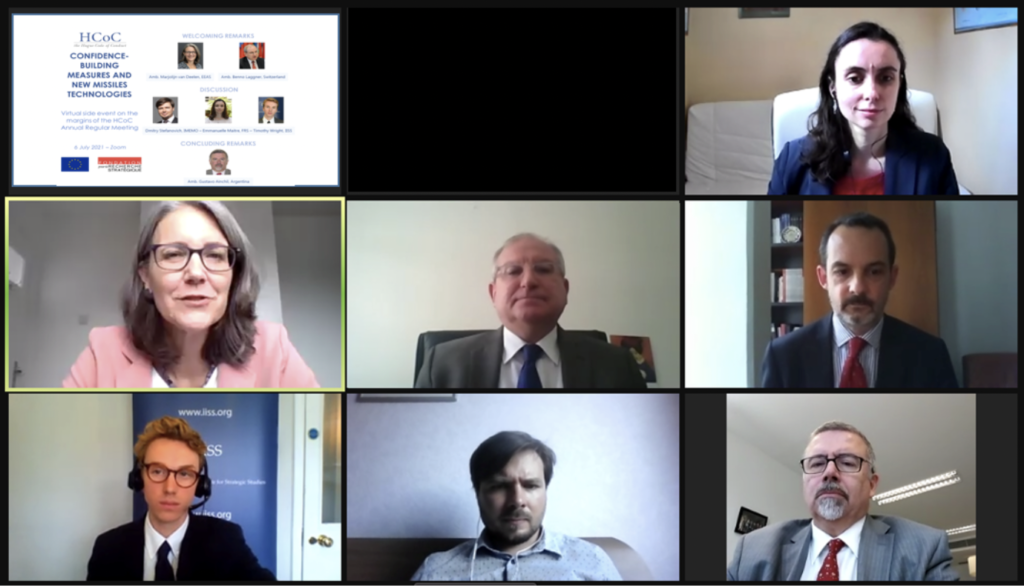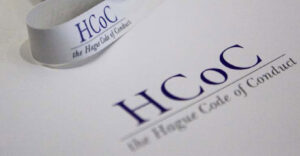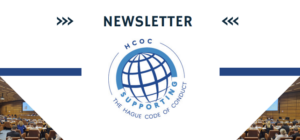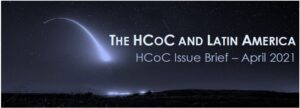Confidence-building measures and new missile technologies
6 July 2021
Virtual
HCoC members states met for the 20th Annual Regular Meeting in Vienna on 7-8 July 2021. The FRS organised a virtual-side event on 6 July 2021, dedicated to participants to the meeting but also open to any states, experts, researchers or representatives from the industry.
The Hague Code of Conduct (HCoC) is a unique set of confidence-building measures dealing with ballistic missiles, whose main benefit is to create transparency on launches and tests and therefore to limit the risk of misinterpretation regarding these activities. Given the ongoing modernisation of systems and the evolution of technologies, there is a need to strengthen the existing framework. This discussion aimed at assessing the role played by the Code today, its adaptation to the rise of new missile technologies and the possibilities of negotiating new confidence-building measures based on the experience of the Code.

AGENDA
INTRODUCTION:
- Amb. Marjolijn VAN DEELEN, Special Envoy for Disarmament and Non-Proliferation, European External Action Service (EEAS), European Union
- Amb. Benno LAGGNER, Resident Representative to the IAEA, Permanent Representative to the CTBTO PrepCom, Permanent Mission of Switzerland, Vienna, Chair of the HCoC 2020-2021
MODERATOR:
- Emmanuelle MAITRE, Research Fellow, FRS
PANELLISTS:
- Dmitry STEFANOVICH, Research Fellow, IMEMO
- Timothy WRIGHT, Research Analyst, IISS
CONCLUSION:
- Gustavo AINCHIL, Ambassador to Austria and Permanent Representative of Argentina to the International Organizations in Vienna
Summary of the debates
Introduction
The proliferation of ballistic missiles, especially those carrying WMD, continues to be of grave concern to the international community, as addressed in United Nations Security Council Resolutions. Current challenges include the acquisition by an increasing number of states of technologies to produce ballistic missiles, and the modernisation of existing systems with increased range, precision and striking power. Several regions are now engaged in a new arms race, creating security risks and political tensions. Given the absence of a legally-binding treaty to curb ballistic missile proliferation, existing confidence-building measures such as the HCoC must be strengthened.
Next year will be the 20th anniversary of the HCoC. In the past twenty years, technologies have evolved at a rapid pace, resulting in a need for the Code to adapt to the changing environment in order to maintain its relevance. This webinar is organised on the eve of the HCoC Annual Regular Meeting (ARM), and is a welcome opportunity to share suggestions and ideas.
The HCoC is an instrument aimed to enhance global peace and security. Its main objectives are to reduce the destabilizing effects of ballistic missile activities through transparency and confidence-building measures. 93 states originally signed the Code when it was adopted in November 2022, while the HCoC now counts 143 subscribing states. It fills an important gap in the arms control, disarmament and non-proliferation architecture, in the absence of a legally-binding treaty. The Code does not prohibit states from possessing ballistic missiles, but provides a set of measures covering both missiles and space launchers to increase confidence and transparency surrounding these systems. Importantly, the Code also does not exclude states “from utilizing the benefits of space for peaceful purposes”.
The pragmatic and limited measures within the HCoC serve to increase predictability and stability, while the low threshold can contribute to encouraging states to subscribe. By subscribing, even states that do not possess any capabilities can demonstrate their commitment to non-proliferation.
A number of challenges remain, namely to promote further universalisation – especially regarding ballistic missile possessors in the Middle East and Asia; to enhance the implementation of commitments; and to address the limited scope of the Code and new technological developments.
Main session: Confidence-building measures and new missile technologies
1/ NEW MISSILE TECHNOLOGIES
What are the main technical evolutions which are bound to play an important role regarding missiles and regarding the Code?
Three main evolutions can be outlined with regards to missile technologies and already play or may play in the future an important role in the efforts to curb ballistic proliferation:
- The development and deployment of hypersonic glide vehicles (HGVs): Russia, China and the United States are among the states developing these systems, but developments are not limited to nuclear-weapon states: South Korea, India and Japan are also among states investing in HGVs.
- The greater availability of technical knowledge to develop ballistic missiles: this can be observed in the cases of the Iranian and North Korean missile programmes.
- The testing of new, improved ballistic systems by HCoC subscribing states, as shown recently by the examples of South Korea (SLBM test) and India (Agni-P).
As a result, ballistic missiles appear increasingly attractive to possess. In the last decade, at least 4 states have acquired such systems, while 13 (or about half of) ballistic missile possessors are not subscribers to the Code to date.
To what extent do hypersonic systems constitute a game-changer or rather a minor evolution?
HGVs themselves do not constitute a game-changer; however there is a possibility that they will have disruptive effects, depending on the amount of vertical and horizontal proliferation they induce. A distinction should be made between the HGVs’ effects for theater and strategic hypersonic weapons: regarding the former, it is true that hypersonic missiles will be faster than existing systems and therefore might cause disruption; however, the latter will increase deliverability of payloads, and thereby might actually increase stability.
Are hypersonic gliders an evolution or a revolution in the framework of the efforts to curb the proliferation of WMD means of delivery, the core objective of the Code?
It depends on how states wish to operationalize HGVs – some are used for conventional purposes while others are used as nuclear delivery systems (and doubts remain about some systems such as the Chinese HGV). The dual capability of many missiles is therefore an unwelcome development in the efforts to curb the proliferation of WMD delivery vehicles.
HGVs have serious implications for stability and deterrence, but their proliferation may be limited at least in the short to midterm due to significant financial and technological implications to develop them.
Are there any civilian technologies (in the field of launchers) that may also have an impact on missile proliferation?
The transfer of civilian technology to the military domain is not as automatic as it may seem. That being said, several technologies including guidance, fuel, and materials are similar. One way forward would be for states developing space launching capabilities to prove that their development and investments only have civilian aims.
2/ INTEGRATION WITHIN THE HCoC
Does the flexibility of the Code constitute an asset, in that it may provide states with the opportunity to change their reporting and non-proliferation practices without the need for a major renegotiation of the instrument, and how can it be used to ensure the pertinence of the Code?
The Code indeed does not refer to any technical specifications – this flexibility constitutes an asset but also a double-edged sword. For instance, the fact that HGVs travel along non-ballistic trajectories for most of their flight is leading some states to argue they might not be part of the HCoC’s scope. That being said, HGVs use a ballistic missile for the boost phase and therefore the Code can integrate them, showing an ability to adapt.
What are the key new types of strike-systems but also civilian technologies that could be included within the scope of the HCoC without changing the philosophy of the instrument?
An important point was made about the HCoC moving from a non-proliferation agenda to a risk reduction agenda. This is useful given our current situation, and the HCoC might be even more successful in reducing risks.
There is no limit when it comes to the HCoC’s scope: even cruise missiles, ASAT missiles and interceptors could be included. It is not an easy task but with existing notifications, a significant amount of data is being shared already. Experts analysing open source data manage to easily find what type of system is about to be tested.
Therefore, states are not so much concerned with sharing relevant notifications (including regarding space launches) themselves; but they are concerned about potential misperceptions. The HCoC should constitute the relevant platform to share problems and misunderstandings.
Is the HCoC, as a pragmatic non-legally binding instrument, well-suited to address the evolutions outlined in today’s discussion?
The HCoC appears to be relatively well adapted to ongoing evolutions, but there remain challenges as technologies continue to rapidly develop.
Moreover, cruise missile proliferation is much more acute than ballistic missile proliferation: with shorter ranges, and historically not linked with WMDs, they have not initially been addressed in the framework of multilateral CBMs such as the Code even though they pose increasing risks.
Conclusion
It is difficult to deny the evolution of technologies since the adoption of the Code, as well as the unavoidable modernisation of systems. Strengthening the existing framework is legitimate and very timely. Having such substantive exchanges constitutes an important step in assessing the role played by the Code, and the possibilities of negotiating new CBMS. A number of open questions can be asked at this stage:
- Can we gather organisational maturity and political will to undertake changes?
- Can we gather such energy without diverting efforts on universalisation?
- Is it advisable or wise to engage in reform while still trying to attract important players? Would we bring uncertainty?
- Are subscribing states ready to renew the same atmosphere of political convergence, the sense of common purpose event if this implies postponing (connected) national concerns?
The HCoC is so far a success story which is contributing to international security, even if it has not reached a universal status yet. Its flexibility makes it rather adequate to withstand some technical evolutions and operational developments. However, some new missile systems which today remain out of the scope of the Code may be growing in importance in the coming years and may also be associated with WMDs. In that context, it may be useful to explore whether minor evolutions could ensure the relevance of the Code in the coming decades but also to take the HCoC as an example to regulate other systems or domains, for instance space.




